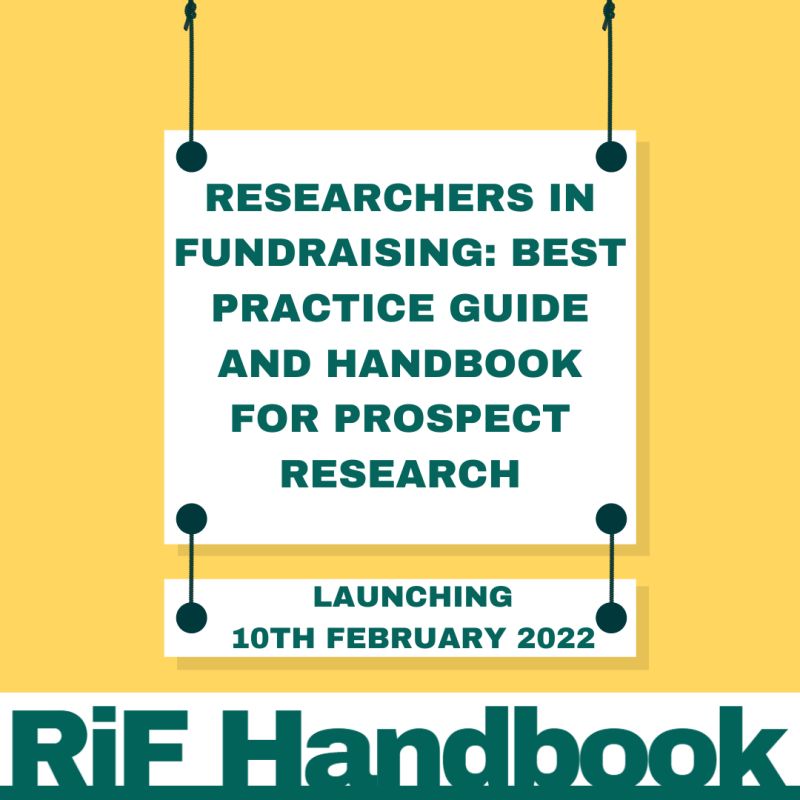 Lots of times we might have a brilliant idea to nudge forward (or perhaps even revolutionize) our profession, but then we think, ugh, is it worth it? That would take forever! And we go back to whatever it was we were doing before our daydream.
Lots of times we might have a brilliant idea to nudge forward (or perhaps even revolutionize) our profession, but then we think, ugh, is it worth it? That would take forever! And we go back to whatever it was we were doing before our daydream.
Fortunately for all of us that’s not what happened back in 2019 when Ben Rymer, then chair of Researchers in Fundraising (RiF), dreamed up the bold idea to create a soup-to-nuts Prospect Research how-to Handbook. In case you’re not familiar with RiF, it’s the professional association for prospect researchers in the UK. Just like Apra here in North America, RiF has a great conference every year (theirs is in November in London) as well as gatherings throughout the year.
The RiF Handbook (available today!), called Researchers in Fundraising: Best Practice Guide and Handbook for Prospect Research has been a labor/labour of love for many of us in the prospect research community. I was lucky enough to be one of the volunteer editors for a segment or two, and I was impressed at what a well-run machine it was, and what a great job that the project’s manager Ally Lee-Dudley, founder of Adcumulo, did of keeping the operation running so smoothly.
I was interested to learn more about the Handbook and the process of creating it, so I got in touch with Ben, Ally, and Chris Davis, RiF’s current chair, to find out more. Sincere thanks to Ben, Ally, and Chris for sharing these great insights!
Helen: Ben, how did the idea come about to do a Handbook for prospect researchers?
Ben Rymer: When I sent the initial proposal to the Chartered Institute of Fundraising (CIoF) in August 2019, I’d known for a while that a handbook/textbook/how-to guide was needed. My feeling was that prospect research was still something of a trade, rather than a profession or discipline. We have a huge amount of expertise, experience and goodwill in the community, but it had never completely crystallised into a finished product so we could build on and improve existing good practice.
HB: What was your initial plan for the scope of the project, and did that change at all as it evolved?
BR: All I knew was that the main areas of research practice should be included. Basically I wanted to create something that I would’ve found practically useful in my first job in the sector. We cast the net wide in starting, with plans for 23 chapters. The big trade-off since then has been in response to volunteer availability. All the content is crowd-sourced, and so we have to work in sequence with the expertise of volunteers who come forward … Also, Covid hit a short time after project kick-off, but we pivoted to remote working pretty well, thankfully.
HB: Ally, how did you get involved with the project?
Ally Lee-Dudley: My involvement with the project began in January 2020 when the Steering Group were looking for a Project Manager to move the Handbook from a great concept to a work in progress. At this time there were not yet any structures, processes, or resources in place so this really was the beginning of the Handbook as an active project.
HB: How many volunteers were part of it?
AL-D: To date around 90 volunteers have contributed to the Handbook, some as writers, some as editors, some as beta-readers, as some as micro-volunteers. Volunteers come from 3 different continents, and around a dozen different countries making the volunteer effort an international collaboration.
HB: How many chapters are there, and how was the decision made on which topics to include?
AL-D: At launch, 8 chapters are available for readers plus a Resource Director and Glossary of industry terms and phrases. There are another 7 chapters in progress which will be published as and when they are completed and a further 11 chapters that are yet to be started. Publishing content on a staggered basis like this means we are able to start getting useful content out and into the prospect research community far more quickly than if we wait for a ‘complete’ Handbook. The original list of potential chapters was developed through discussions between the volunteers who make up the RiF Committee. Over time several additional chapters have been added to that list as a result of suggestions made by volunteers involved with the project.
HB: Chris, as the scope of the project evolved, what changes did that cause you to make?
Chris Davis: As we added more chapters to the Handbook, we found ourselves looking beyond our immediate peer group for input and advice, to those with specific expertise or lived experience. For example, in our chapter on Strategic International Prospecting, we were aware that we needed to get as much input as possible not only from researchers with extensive knowledge of international prospect research, but also from those with experience of living or working in different countries and communities. This was definitely a challenge, but I hope we got the balance right! Similarly, when we start work on the chapter on Equality, Diversity & Inclusion in Prospect Research we’ll be seeking involvement from those who are experts in the ED&I space.
HB: What surprised you most about the process, or what created the most changes or opportunities as things went along?
CD: I think I was surprised by how much content we ended up generating! I knew that the prospect research community would be hugely generous with their time and knowledge, but I was still taken aback at times by the volume of work we ended up producing. At this point I’d have to give a big shout out to our beta-reading and editing volunteers, who were a major help in clarifying and refining the chapters and getting them to where they are now.
HB: Ben, what do you think are the top 3 things that readers will find that might surprise them?
BR: 1. Reach: it is a big thing! Chapters I’ve worked on have ended up being 10,000-20,000 words long. We also have a very broad range of topics, so I think readers will be pleasantly surprised at that.
- What’s still to come: by the same token, there are some big chapters in the pipeline, so reader may be left waiting for those. If anyone has suggestions, please feel free to get in touch via the Handbook website, www.rifhandbook.info.
- Quality: we’ve put a lot of effort into making the content as good as it can be. For a wholly volunteer-generated initiative I think it is a solid product, but I’m biased of course!
HB: Chris, what do you think are the top things that you think readers will find most useful in the Handbook?
CD: I think that will be different depending on the needs and experiences of readers – throughout the Handbook we’ve tried to ensure that content is relevant for both those who are new to prospect research and for experienced researchers who are looking to innovate and upskill.
For early-career researchers or those who are setting up a prospect research function, we hope our New Researchers Guide chapter and the chapter on The Prospect Research Role will be invaluable. Within the Data & Skills Domain of the Handbook, there is some very detailed, nuanced, and in-depth content on estimating wealth and assigning capacity ratings – topics that we know are of eternal interest to prospect researchers and fundraisers alike!
Finally, we’ve made extensive use of case studies throughout the Handbook, drawn from the real-life experiences of researchers. We hope these will really bring the content the life and illustrate how the principles and techniques outlined in the Handbook can be applied practically.
HB: Chris, what did you enjoy most about the process?
CD: I’ve really enjoyed the experience of being involved in creating content for the Handbook, especially the early stages of this where you are exchanging knowledge with your peers. I’ve been working in prospect research for over a decade, but being involved with the Handbook has absolutely encouraged to rethink some of my settled views about the work that we do, and how we do it. I think the Handbook does reflect this process of peer exchange, and I hope that everyone who uses it will find something new and different in there that challenges their assumptions.
HB: Ally, What tools did you use for collaboration on this massive project and how well did they work? If you had another large collaborative project to undertake, would you use the same tools?
AL-D: The Handbook was always intended to be primarily a remote project, so in that sense we were lucky and the pandemic didn’t significantly affect our plans. In order to help ensure both accessibility of tools at no cost for volunteers and to help embed project sustainability by keeping the financial burden of the project low for RiF, we’ve largely drawn on tools that are available for free. As a Steering Group, our project management hub is a tool called Freedcamp, and this enables us to plot and track actions, deadlines, and milestones and assign task accountability at a strategic level.
For the Handbook’s wider volunteer community, the free version of MS Teams is our collaborative workspace. Teams provides us with a place to create, share, and store documents such as meeting agendas and action plans, and to work collectively on producing and editing content in real-time whilst being able to communicate quickly and easily with each other. Within Teams volunteers can access the web versions of MS Word and Excel so we’re all using the same tools to ensure compatibility plus there is in-build versioning history and storage back-up for those ‘just in case’ moments. We’ve recently made the switch from using Zoom for our regular meetings to using MS Teams’ video calling service; it doesn’t quite have all the same features as Zoom but it does come at zero cost rather than requiring a subscription to hold meetings for small groups for up to an hour at a time.
The Handbook itself is created using a custom-made WordPress website. We chose the route of e-publishing over hard copy for several reasons and the WordPress platform, with its almost unlimited flexibility and versatility, is the best fit to meet the Handbooks needs both now and in the future. As an e-publication it is not only much easier to keep the Handbook content up to date, it is also far simpler to ensure its availability to readers around the world who can access the content from any device with a web browser.
Overall, aside from the usual occasional IT glitch, (we’ve done the equivalent of turn it off and on again once or twice), the tools we’ve chosen have been effective and created not only a conduit for remote productivity and development, but also a space to come together a a community and experience that sense of being part of a team working towards a common goal that is so important to the Handbook.
Many thanks again to Ben, Chris, and Ally for sharing the inside scoop on the RiF Prospect Research Handbook, and for all of the hard work and coordination that went into creating it! Check out the Handbook website at www.RiFHandbook.info. If you would like to be a volunteer writer or editor for future chapters, please visit this page to learn more.



